 Part of our Time Traveler Series, this post was contributed to by both Angie George and Brian Shifflet, Shores & Islands Ohio Visitor Services Managers
Part of our Time Traveler Series, this post was contributed to by both Angie George and Brian Shifflet, Shores & Islands Ohio Visitor Services Managers
Christmas:
For centuries, people around the world have held mid-December celebrations, but Christmas, as we know it in today’s America, wasn’t declared a Federal Holiday until 1870. Centuries before the birth of Jesus, the Winter Solstice, which falls on December 21, was celebrated by most of Europe. It was a time to enjoy the meat from animals slaughtered for the winter and partake in libations that had become fermented. The Winter Solstice marks the day with the shortest period of daylight; therefore, December 21 was a time to rejoice in the fact the days were beginning to get longer. This was especially significant in a time before the invention of artificial lighting.
Traditionally, in Christianity, as the Bible doesn’t mention Jesus’ actual birth date, Easter was the main holiday celebrated. In the 4th century, it was Pope Julius I who chose December 25; however, most historians believe Christ’s birthday was most likely sometime in the spring as that is usually when shepherds would typically be herding sheep.
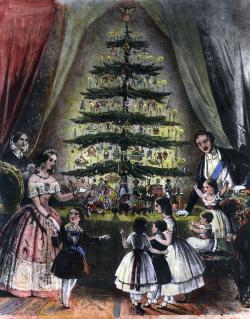 By choosing a mid-December date, Pope Julius I hoped to increase the chances that Christmas would be embraced as it coincided with existing traditional Winter Solstice festivals. The date December 25 also aligned with the pagan festival known as Saturnalia, or the Feast of the Nativity. Begun in Egypt around 432 A.D., by the 6th century, the tradition made its way to Europe. Historians believe the Catholic Church chose this date as a way to convert a pagan holiday into a Christian one. It did the trick as by the Middle Ages, Christianity had mostly replaced pagan religion.
By choosing a mid-December date, Pope Julius I hoped to increase the chances that Christmas would be embraced as it coincided with existing traditional Winter Solstice festivals. The date December 25 also aligned with the pagan festival known as Saturnalia, or the Feast of the Nativity. Begun in Egypt around 432 A.D., by the 6th century, the tradition made its way to Europe. Historians believe the Catholic Church chose this date as a way to convert a pagan holiday into a Christian one. It did the trick as by the Middle Ages, Christianity had mostly replaced pagan religion.
Before too long, the holiday began to have unintended consequences when Christmas turned into a raucous holiday with crowds of drunken celebrants going to upper-class homes, knocking on doors, and insisting on being served food and drinks. If the residents declined, the crowd would get rowdy. Upper-class families began to view it as a time of year to be generous to those less fortunate and “repay their debt to society”.
In the early years of America, the Pilgrams’ puritan beliefs deemed Christmas celebrations to be too rowdy and secular. In fact, from 1659-1681, celebrating the holiday was illegal in parts of New England. After the Revolutionary War, Christmas customs mostly fell out of fashion altogether. In the 19th century, things began to shift. In 1824, Clement Clarke Moore’s poem An Account of a Visit from St. Nicholas (now commonly known as ‘Twas the Night Before Christmas) tells a story of a modern Santa Claus riding his sleigh with his 8 tiny reindeer to deliver presents on Christmas Eve. In 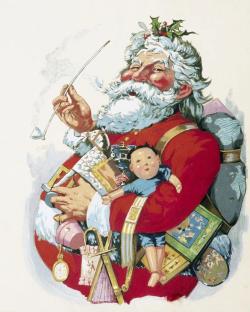 the 1840s, Charles Dickens’ A Christmas Carol was published. This now classic book tells the story of Christmas being a time to be generous and kind to others. Also in the 1840s, was Queen Victoria’s wedding to German Prince Albert. Prince Albert brought many German traditions to England, such as putting up a Christmas tree. During the American Civil War more modern Christmas celebrations began taking root. Faced with the sudden loss of so many loved ones, society began to embrace the importance of family time. The 1862 Christmas issue of Harper’s Weekly newspaper featured an illustration of Santa Claus visiting Union camps to hand out gifts. After the Civil War, and with the rise of the middle class, people suddenly had disposable income to purchase gifts to give. Technologies in printing meant beautifully colored cards were now available to send. In the 1880s, Harper’s Weekly newspaper hired famous illustrator, Thomas Nast, to illustrate Santa with his sack full of gifts to be placed front-and-center on the cover. This act solidified the jolly ole elf with his belly full of jelly as a Christmas staple.
the 1840s, Charles Dickens’ A Christmas Carol was published. This now classic book tells the story of Christmas being a time to be generous and kind to others. Also in the 1840s, was Queen Victoria’s wedding to German Prince Albert. Prince Albert brought many German traditions to England, such as putting up a Christmas tree. During the American Civil War more modern Christmas celebrations began taking root. Faced with the sudden loss of so many loved ones, society began to embrace the importance of family time. The 1862 Christmas issue of Harper’s Weekly newspaper featured an illustration of Santa Claus visiting Union camps to hand out gifts. After the Civil War, and with the rise of the middle class, people suddenly had disposable income to purchase gifts to give. Technologies in printing meant beautifully colored cards were now available to send. In the 1880s, Harper’s Weekly newspaper hired famous illustrator, Thomas Nast, to illustrate Santa with his sack full of gifts to be placed front-and-center on the cover. This act solidified the jolly ole elf with his belly full of jelly as a Christmas staple.
Hanukkah:
Most people are likely unaware that the celebration of Hanukkah in America has its roots in Ohio! Before we get to that part of the story, however, let’s start with a little background. Hanukkah is a fairly minor festival in the Jewish year in a religious sense. It has none of the prohibitions from work or other activities that accompany the larger holidays such as Rosh Hashanah, 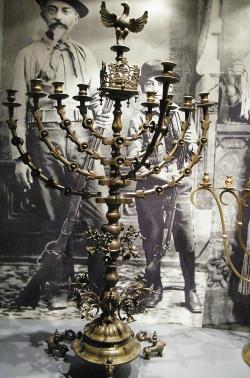 Yom Kippur, Passover, or weekly Shabbat. It also is a bit of a more recent holiday, commemorating events of the Maccabees that happened much later than the writing down of the books of Torah. With all this being said, it will make sense that while festive, Hanukkah (or Chanukah, Hanukah, Chanukkah, etc.) was often a small home-based celebration, not the large winter festival you may know today. So how has this holiday become possibly the best-known Jewish holiday through the United States?
Yom Kippur, Passover, or weekly Shabbat. It also is a bit of a more recent holiday, commemorating events of the Maccabees that happened much later than the writing down of the books of Torah. With all this being said, it will make sense that while festive, Hanukkah (or Chanukah, Hanukah, Chanukkah, etc.) was often a small home-based celebration, not the large winter festival you may know today. So how has this holiday become possibly the best-known Jewish holiday through the United States?
Jewish immigration to the U.S. began slowly, with small Jewish populations throughout the original colonies. Many early Jewish immigrants were from Sephardic communities (these are Jews who originally inhabited the Iberian Peninsula but were spread through Europe by the inquisition). By 1840 the population only numbered 15,000 in the entire country. The population grew quickly though, by 1848 numbering 50,000 and then a large Ashkenazic (Jews of primarily German and Eastern European decent) immigration through the late 19th century into the early 20th century. Many of these immigrants came from communities where public displays of Jewishness were not accepted by the community, to say the least. This meant that most immigrants were not used to being able to publicly celebrate holidays outside of their homes or synagogues.
The first documented Jewish immigrant to Ohio was named Joseph Jonas and he immigrated from England to Cincinnati in 1817. The population of Jewish immigrants in Ohio grew steadily through the 19th century, particularly in Cincinnati and Cleveland. In fact, it is from Cincinnati that we begin to develop our modern, American style of celebrating Hanukkah. Cincinnati holds a distinction as being the city that created the modern Reform Jewish denomination. Two reform rabbis in Cincinnati, Isaac Mayer Wise and Max Lilenthal, realized that many children were not attending 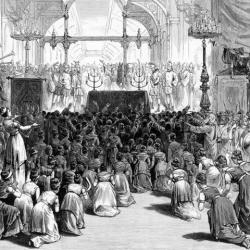 synagogue and felt that Hanukkah was a perfect way to get them involved in a less “serious” holiday. Beginning in the mid-19th century, these rabbis began writing, encouraging American Jews to embrace the Hanukkah celebration both at synagogue or temple and in their homes. And it began to work! This may have been, in large part actually, because of the style of celebration. Instead of a more traditional prayer service, these rabbis brought families to the temple to tell the Hanukkah story, light the hanukkiah (the proper name of the Hanukkah menorah), and gave out sweets and small gifts. Who wouldn’t like that?
synagogue and felt that Hanukkah was a perfect way to get them involved in a less “serious” holiday. Beginning in the mid-19th century, these rabbis began writing, encouraging American Jews to embrace the Hanukkah celebration both at synagogue or temple and in their homes. And it began to work! This may have been, in large part actually, because of the style of celebration. Instead of a more traditional prayer service, these rabbis brought families to the temple to tell the Hanukkah story, light the hanukkiah (the proper name of the Hanukkah menorah), and gave out sweets and small gifts. Who wouldn’t like that?
As the Jewish population grew, so did some of the celebrations, and you can see where we’ve ended up today! Many (perhaps most?) American Jews celebrate Hanukkah in some way, whether it be lighting the hanukkiah or eating the traditional fried foods like latkes (potato pancakes) and sufganyot (jelly donuts), and many exchange small gifts and sweets. If you are curious to learn more about the history and traditions of Hanukkah from a Reform Jewish perspective, I would encourage you to visit:
https://reformjudaism.org/jewish-holidays/hanukkah/history-hanukkah-story
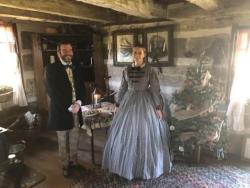 Happy Holidays and Chag Chanukah samaech!
Happy Holidays and Chag Chanukah samaech!
Fun Facts about Christmas and Hanukkah:
- The legend of Santa Claus can be traced back to a Turkish monk named St. Nicholas who was born 280 A.D.
- There are roughly 15,000 Christmas tree farms in the U.S., and trees usually grow for between four and 15 years before they are sold.
- The first eggnog made in the U.S. was consumed in Jamestown settlement (Virginia) in 1607.
- Poinsettias are native to Mexico and brought to the U.S. in 1828 by Joel R. Poinsett, an American minister to Mexico.
- During World War I, on Christmas Eve 1914, British and German troops ceased combat, and came together to celebrate Christmas.
- Because Hanukkah is actually a Hebrew word (Hebrew does not use our same alphabet), there are 24 different spellings of the holiday in English.
- The word Hanukkah in Hebrew means “dedication” as the holiday celebrates the rededication of the Second Temple in Jerusalem.
- Since the date of Hanukkah (the 25th of Kislev) is based in the Jewish calendar, the date shifts on the Gregorian calendar anywhere between mid-November to late-December.
- In 1993, astronaut Jeff Hoffman brought a travel-size menorah and spun a dreidel while on the Space Shuttle Endeavour!



